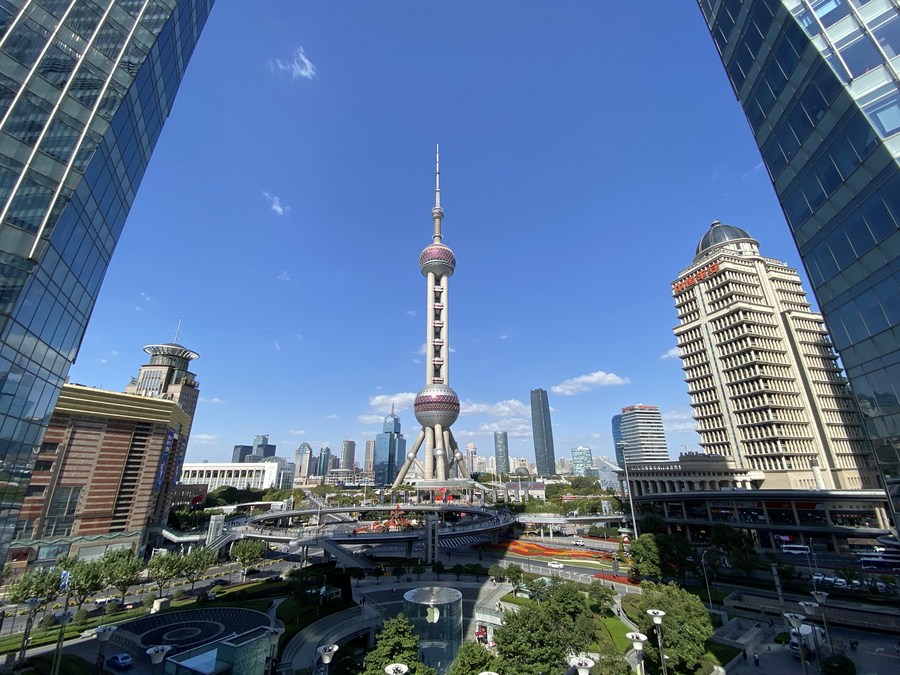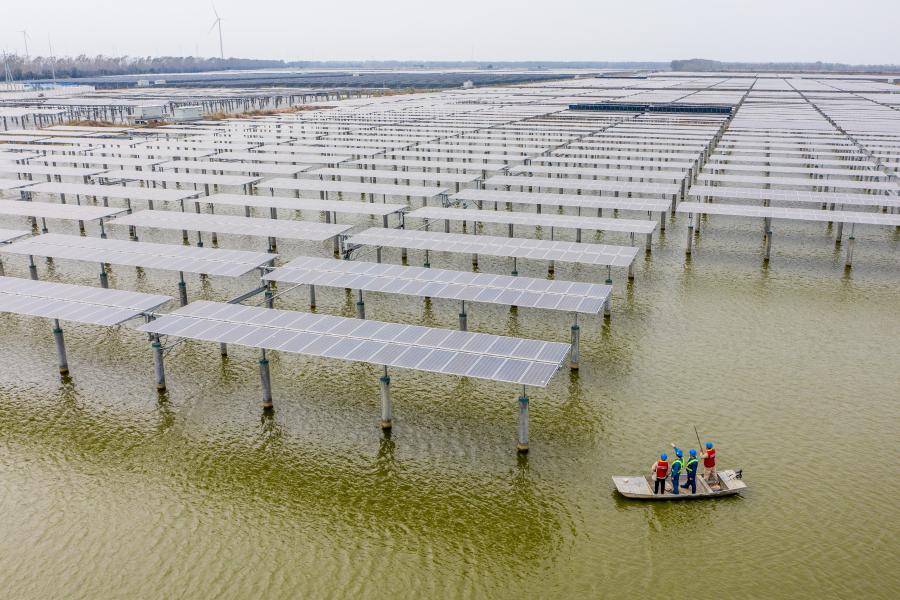


Photo taken on Nov. 3, 2020 shows the view of the Lujiazui area of Pudong, east China's Shanghai. (Xinhua/Ding Ting)
The year 2021 marks an important milestone in the modernization of China's economy as its gross domestic product pierced through the 100-trillion-yuan threshold for the first time.
With the introduction of a new development pattern in 2020, along with effective government measures to prevent and control COVID-19, the country has established a solid footing to begin embarking on its 14th Five-Year Plan (2021-2025).
"The general trend for China's economy is favorable and will remain unchanged," Zhang Yuxian, director of the Department of Economic Forecasting at the State Information Center, told People's Daily earlier this week.
"Despite facing a severely complicated environment, China was the only major world economy to realize positive economic growth last year, which greatly boosted confidence in the country's economy among market and institutional players both at home and abroad," Zhang said.
Having weathered the storm of repeated assaults from COVID-19, along with other external shocks, China's technological, economic and comprehensive national power are continuing to rise to new heights.
Looking to 2021, Zhang foresees a steady rebound in China's economic growth underpinned by its rich labor and capital resources, a rapid expansion in scientific and technological innovation, and a robust supply of factors of production, while its consummate industrial system, large-scale production capacity, advanced infrastructure and well-developed logistics networks continue to ensure the economy's favorable operations.
The country's population of 1.4 billion and a 400 million strong and growing group of middle-income consumers, when combined with the complementarity of urban-rural and east-west regions of the country, also opens the door to an enormous domestic market and provides significant room for continued expansion.
Zhang noted however that there still remain many uncertainties ahead regarding the global economic environment and international efforts to tackle the COVID-19 pandemic.
In view of the extraordinary circumstances facing policymakers, Zhang acknowledged that keeping economic growth within a reasonable range while balancing systemic risks will remain a formidable task.
The Central Economic Work Conference concluded in December, pledged its full support for the world's second-largest economy on its path to recovery, concentrating on efforts to promote continued reform and innovation while maintaining the continuity, stability and sustainability of macroeconomic policies.
Realizing the huge potential of the domestic market
A significant pillar of China's shift towards a new model of economic development will involve taking advantage of the country's enormous domestic market, including by enhancing the basic role of the Chinese consumer.
"Realizing the huge potential of the domestic market is an essential component for building a new development pattern, which requires carrying out effective institutional arrangements for consumption, savings and investment, among other aspects of the economy," Zhang said. "On the strategic basis of continually expanding internal demand, one must look to consumption as the primary engine."
Policymakers have already signaled their intention to accelerate implementation of the "dual circulation" strategy that takes the domestic market as the mainstay, with internal and external markets reinforcing each other.
Harnessing the full economic strength of end consumers in China requires initiating effective demand-side reforms to reduce bottlenecks and further promote overall consumption activity.
A series of supportive measures could serve to bolster public and private consumption by upgrading the consumption structure and raising people’s consumption capacities.
This includes strengthening vocational and technical training to expand and improve the quality of jobs, optimizing the income distribution structure, expanding new forms of consumption, eliminating administrative restrictions on consumption, and tapping into the large potential for consumption at the county and township levels.
Zhang also referred to the healthy development of cross-border e-commerce and efforts to strengthen Chinese brands, while improving the overall consumption environment through enhanced consumer protections and the development of "new infrastructure."
When deployed rationally, investment will also continue to play a critical role in driving renewed infrastructure construction, urbanization and technological transformation.

Electricians check photovoltaic solar panels in Sheyanghu Township of Baoying County, east China's Jiangsu Province, Nov. 5, 2020. (Xinhua/Li Bo)
Enhancing industrial and supply chains through increased autonomy and self-control
With China's economy expected to expand by 8.4 percent in 2021 following its return to a normal growth trajectory in the second half of 2020, the country must now set its sights on increasing its industrial resiliency and steering growth momentum towards a new level of high-quality economic and social development.
"When it comes to enhancing industrial and supply chains through increased autonomy and self-control, China has an unparalleled advantage," Zhang said.
"At present, China is the manufacturing center of the world, as well as one of its major consumption hubs, meaning that the country is primed to attract international capital, technology and talent as a flourishing base for future economic development."
A push for greater self-sufficiency will require maintaining the strength of China's manufacturing core, transforming and upgrading its traditional industries, and ratcheting up the intensity, scale and sources of investment into basic R&D.
"We need to foster the transformation and upgrading of traditional industries to move up the industrial and supply chains, making them smart, greener, and speeding up the integration of information technology and manufacturing," Zhang highlighted. "We need to continue to dig deep and carefully cultivate our industrial competitiveness."

 Award-winning photos show poverty reduction achievements in NE China's Jilin province
Award-winning photos show poverty reduction achievements in NE China's Jilin province People dance to greet advent of New Year in Ameiqituo Town, Guizhou
People dance to greet advent of New Year in Ameiqituo Town, Guizhou Fire brigade in Shanghai holds group wedding
Fire brigade in Shanghai holds group wedding Tourists enjoy ice sculptures in Datan Town, north China
Tourists enjoy ice sculptures in Datan Town, north China Sunset scenery of Dayan Pagoda in Xi'an
Sunset scenery of Dayan Pagoda in Xi'an Tourists have fun at scenic spot in Nanlong Town, NW China
Tourists have fun at scenic spot in Nanlong Town, NW China Harbin attracts tourists by making best use of ice in winter
Harbin attracts tourists by making best use of ice in winter In pics: FIS Alpine Ski Women's World Cup Slalom
In pics: FIS Alpine Ski Women's World Cup Slalom Black-necked cranes rest at reservoir in Lhunzhub County, Lhasa
Black-necked cranes rest at reservoir in Lhunzhub County, Lhasa China's FAST telescope will be available to foreign scientists in April
China's FAST telescope will be available to foreign scientists in April